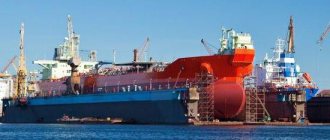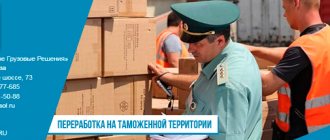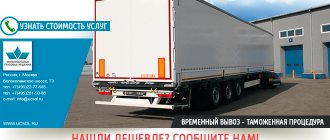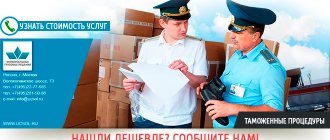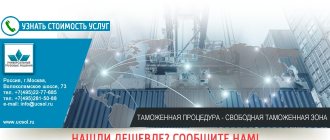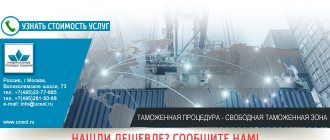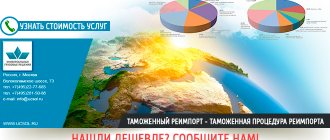HomeCustoms clearanceCustoms procedures Processing outside the customs territory
Processing outside the customs territory is a customs procedure in which goods are exported from the territory of the EAEU for the purpose of processing: processing, repair, manufacturing, modernization and replacement of spare parts, for subsequent return back to the sender. The application of this procedure implies exemption from payment of export customs duties, and when re-importing, import customs duties are paid from the amount of processing outside the customs territory: fee, duty, VAT or excise tax, depending on the type of product.
The code for the customs procedure for processing outside the customs territory is EK21, which is indicated when filling out column 1 of the customs declaration by a legal entity or individual entrepreneur during electronic customs declaration.
Column 1 consists of three cells and is filled out as follows:
|
More details about filling
Contents of the customs procedure for processing outside the customs territory
The customs procedure for processing outside the customs territory can be used: for the export of goods from the territory of the EAEU, their processing and the return of processed products. It is used to manufacture new goods from those exported from the territory of the EAEU. This procedure is used when it is necessary to carry out paid or free repairs of a car, machine, equipment, vessel, including those related to the replacement of components. It can be used to upgrade equipment.
To test the operation of equipment and its settings, it is not recommended to place it under the processing procedure outside the customs territory ; it is more correct to use the temporary export procedure.
Important! There are goods that cannot be placed under this procedure; their list was approved by the Decision of the EEC Board of September 10, 2021 N 150 of September 10, 2021 N 150.
The action of processing outside the customs territory can be completed by placement under customs procedures: re-import, release for domestic consumption or export. If the processing procedure outside the customs territory is completed by placement for export, then the goods will not be returned to the territory of the EAEU.
Do you need to complete the procedure for processing outside the customs territory? - We will help you!
Product replacement
It is carried out in accordance with Art. 259 TK. Processed products can be replaced with foreign goods if:
- Operations involve performing repairs.
- Control services do not identify products.
Replacement is carried out with products that, in their technical characteristics and quality, coincide with the above products. If this operation has been authorized, the import of foreign products is allowed until export outside the control zone. The procedure for carrying out replacement is established in the legislation of the CU member countries.
Rules and features of processing processing outside the customs territory
Individuals cannot use the processing procedure outside the customs territory.
A legal entity or individual entrepreneur can place goods under the processing procedure outside the customs territory, provided that they have documents with a detailed description of the conditions of this operation, its timing, the resulting goods, waste and other details. In this case, other accompanying documents for the goods may also be required. Also, to register processing outside the customs territory, a completed declaration will be required. The processing procedure must be carried out in compliance with all established rules, as well as prohibitions and restrictions. Customs duties and other taxes and fees are not required to be paid, but may be charged under certain conditions.
Customs payments
The following rules for paying taxes and duties apply to imported products:
- Full exemption is provided for products exported for repairs. For goods previously released for free circulation within the customs territory, benefits are not provided. This rule applies if the presence of a defect was taken into account, to eliminate which repairs were carried out.
- Partial release. It applies in all other cases.
Conditions for placing goods under the processing procedure outside the customs territory
The condition for placement under the processing procedure outside the customs territory is the provision of a document to the customs authority on the conditions for processing the goods. This document must contain all the necessary information specified in the TC. Among them, technological operations and the timing of their implementation should be indicated. In addition, it is necessary to indicate the possibility of identifying exported goods in processed products. If replacement with an identical foreign product is provided, then identification is not required. To unambiguously identify a product, the use of seals, stamps, various marking methods, descriptions and photographs is provided. As a method of identification, comparison of samples and specimens, as well as existing applied serial numbers, can be used. The condition is also to comply with the established deadline for placement under the procedure.
Refusal to satisfy the application
The customs authority may not issue a permit to the entity to process products outside the control zone. Refusal is permitted in the following cases:
- Failure to provide information about the proposed operations defined in the Labor Code.
- If the conditions of the procedure are not followed.
- When the control service makes a decision to refuse to agree on the stated yield standards and the duration of the operations.
The declarant is notified of the grounds on which the customs authority will not issue him a permit.
Time limit for processing goods outside the customs territory
When completing the procedure, the period for processing goods outside the customs territory must be indicated. It consists of the time required to process the goods and the time it takes to transport the goods to the place of processing and back. It is important to remember that you must meet the specified deadline; if you cannot meet it, it will have to be extended. The law allows for an extension if no more than 10 days have passed since the end of the established period. The duration of this procedure is no more than 2 years.
Processing for domestic consumption
This procedure is the reverse of the above. Processing for domestic consumption – import of foreign products into the EAEU member state for processing. No import duties are required. When goods are re-released abroad, the rates for processed products apply.
Only such processing is allowed during which foreign products will lose their specific characteristics. The deadlines are set based on the duration of the process. It is possible to extend them. But the total processing time is no longer than 1 year.
Currently, the practical application of the procedure in the Russian Federation is impossible. The government has not established a list of goods for which it is acceptable.
Registration of the customs procedure for processing cargo and goods outside the customs territory
Ours is a customs representative - broker and carries out prompt clearance of the customs procedure for processing outside the customs territory of any cargo and goods at any customs offices of the Russian Federation:
- At airports
- In seaports
- At railway stations
- At cargo automobile terminals – temporary storage warehouse
- Express postal items
If necessary, we carry out customs clearance of goods in any other customs procedures!
We work with any participants in foreign trade activities:
- Individuals
- Legal entities
- Individual entrepreneurs
Eurasian Economic Commission
Article 252. Contents of the customs procedure for processing outside the customs territory1. Processing outside the customs territory is a customs procedure in which goods of the customs union are exported from the customs territory of the customs union for the purpose of carrying out processing operations outside the customs territory of the customs union within the established time frame with full conditional exemption from payment of export customs duties and without the use of non-tariff regulation measures with the subsequent import of processed products into the customs territory of the Customs Union.
2. Goods placed under the customs procedure of processing outside the customs territory and actually exported from the customs territory of the customs union lose the status of goods of the customs union.
Article 253. Conditions for placing goods under the customs procedure of processing outside the customs territory
1. Placement of goods under the customs procedure of processing outside the customs territory is permitted provided:
1) provision of a document on the conditions for processing goods outside the customs territory, issued by the authorized body of a member state of the customs union and containing information specified in Article 257 of this Code.
If the purpose of placing goods under the customs procedure of processing outside the customs territory is their repair, a customs declaration may be used as the document specified in part one of this subparagraph;
2) the possibility of identifying goods of the customs union in the products of their processing by customs authorities, with the exception of the case of replacement of processed products with foreign goods in accordance with Article 256 of this Code.
2. The Commission of the Customs Union has the right to determine the list of goods prohibited from being placed under the customs procedure of processing outside the customs territory.
3. Goods placed under the customs procedure of release for domestic consumption with the provision of benefits for the payment of customs duties and taxes associated with restrictions on the use and (or) disposal of goods may be placed under the customs procedure of processing outside the customs territory for operations to repair them .
Article 254. Processing operations outside the customs territory
Operations for processing goods in the customs procedure of processing outside the customs territory include:
1) processing or processing of goods, during which the goods lose their individual characteristics;
2) manufacturing of goods, including installation, assembly, disassembly and adjustment;
3) repair of goods, including its restoration, replacement of components.
Article 255. Identification of customs union goods in processed products
In order to identify goods of the Customs Union in their processed products, the following methods can be used:
1) affixing by the declarant, the person carrying out processing, or officials of customs authorities of seals, stamps, digital and other markings on the original goods of the customs union;
2) a detailed description, photography, and scale depiction of goods of the customs union;
3) comparison of pre-selected samples, samples of customs union goods and their processed products;
4) use of existing product markings, including in the form of serial numbers.
5) other methods that can be applied based on the nature of the goods and the operations carried out for processing goods, including by examining the detailed information provided on the use of customs union goods in the technological process of carrying out operations for processing goods, as well as on the technology for producing processed products.
Article 256. Time limit for processing goods outside the customs territory
1. The period for processing goods outside the customs territory cannot exceed 2 (two) years.
The period for processing goods begins from the day they are placed under the customs procedure for processing outside the customs territory, and when customs declaring goods in separate batches (several batches) - from the day the first batch of goods is placed under this customs procedure.
2. The period for processing goods outside the customs territory includes:
1) the duration of the production process of processing goods;
2) the time required for the actual import of processed products and their placement under customs procedures that complete the customs procedure for processing outside the customs territory.
3. The period for processing goods outside the customs territory may be extended within the period established by paragraph 1 of this article.
4. The procedure for establishing and extending the period for processing goods outside the customs territory is determined by the legislation of the member states of the customs union.
Article 257. Document on the conditions for processing goods outside the customs territory
1. A document on the conditions for processing goods outside the customs territory, issued by the authorized body of a member state of the customs union, can be received by any person of the member state of the customs union on the territory of which this document is issued.
2. The document on the conditions for processing goods outside the customs territory must contain the following information about:
1) the person to whom the document was issued;
2) the person (persons) who will (will) directly carry out processing operations;
3) the name, classification of goods of the customs union and their processed products in accordance with the Commodity Nomenclature of Foreign Economic Activity, their quantity and value;
4) documents confirming the completion of a foreign economic transaction or other documents confirming the right to own, use and (or) dispose of goods not within the framework of a foreign economic transaction;
5) yield standards for processed products;
6) operations for processing goods, methods of their implementation;
7) methods of identifying goods;
 the period for processing goods outside the customs territory;
the period for processing goods outside the customs territory;
9) replacement of processed products with foreign goods, if such replacement is allowed;
10) the customs authority (customs authorities), in which the goods are supposed to be placed under the customs procedure of processing outside the customs territory and the completion of this customs procedure.
3.
A document on the conditions for processing goods outside the customs territory, in addition to the information provided for in paragraph 2 of this article, may contain other information if this is established by the legislation of the member states of the customs union.
4. The form and procedure for issuing a document on the conditions for processing goods outside the customs territory, making changes or additions to it, as well as its revocation (cancellation) is determined by the legislation of the member states of the customs union.
5. The release of goods of the customs union in accordance with the customs procedure for processing outside the customs territory is carried out by the customs authority of a member state of the customs union, whose authorized body has issued a document on the conditions for processing goods outside the customs territory.
Article 258. Norms for the release of processed products outside the customs territory
1. The yield rate of processed products is understood as the quantity or percentage of processed products formed as a result of processing a certain amount of goods of the customs union.
2. If processing operations outside the customs territory are carried out in relation to goods, the characteristics of which remain practically constant, are usually carried out in accordance with clearly established technical requirements and lead to the receipt of processed products of unchanged quality, standard yield standards may be established by the competent authorities of the member states of the customs union processed products.
Article 259 .
Replacement of processed products with foreign goods
1. With the permission of the customs authority, it is allowed to replace processed products with foreign goods that, in their description, quality and technical characteristics, coincide with processed products, if the processing operations are warranty repairs, as well as when moving goods by pipeline transport .
2. If the replacement of processed products with equivalent foreign goods is permitted, the import of these foreign goods is permitted before the export of goods of the customs union outside the customs territory of the customs union. In this case, the procedure for such replacement is determined by the legislation of the member states of the customs union.
Article 260. Completion of the customs procedure for processing outside the customs territory
1. The customs procedure for processing outside the customs territory is completed before the expiration of the period for processing goods by placing the processed products under the customs procedures of re-import or release for domestic consumption in the manner and under the conditions provided for by this Code.
The customs procedure for processing outside the customs territory may be completed before the expiration of the period for processing goods by placing goods that have not undergone processing operations under the customs procedures of re-import or export in the manner and on the conditions provided for by this Code.
The customs procedure for processing outside the customs territory cannot be completed by the customs procedure for export if, by the legislation of the member states of the customs union, goods placed under the customs procedure for processing outside the customs territory and (or) the products of their processing are subject to mandatory return to the territory of the member state of the customs union.
2. Processed products may be placed under customs procedures for re-import and release for domestic consumption in one or more batches (shipments).
Article 261. The emergence and termination
of the obligation to pay export customs duties and the deadline for their payment in relation to goods placed (placed) under the customs procedure of processing outside the customs territory
1. The obligation to pay export customs duties in relation to goods placed under the customs procedure of processing outside the customs territory territory, arises for the declarant from the moment of registration of the customs declaration by the customs authority.
2. The obligation to pay export customs duties in respect of goods placed (placed) under the customs procedure of processing outside the customs territory is terminated for the declarant:
1) upon completion of the customs procedure for processing outside the customs territory before the expiration of the period for processing goods in accordance with paragraph 1 of Article 260 of this Code, except for the case when during the validity of this procedure the deadline for payment of export customs duties has come;
2) in the cases specified in paragraph 2 of Article 80 of this Code.
3. The deadline for payment of export customs duties is considered to be:
1) when transferring goods to a person who is not a person who directly carries out processing operations, without permission from the customs authorities - the day of transfer of goods, and if this day is not established - the day the customs authority identifies the fact of transfer of goods;
2) in case of loss of goods before the expiration of the period for processing the goods, with the exception of destruction (irretrievable loss) due to an accident or force majeure or natural loss under normal conditions of transportation (shipment) and storage - the day of loss of the goods, and if this day is not established - the day identification by the customs authority of the fact of loss of goods;
3) if the customs procedure for processing outside the customs territory is not completed before the expiration of the period for processing of goods in accordance with paragraph 1 of Article 260 of this Code - the day of expiration of the period for processing of goods.
4. Export customs duties are subject to payment in amounts corresponding to the amounts of export customs duties that would be payable when placing goods under the customs procedure for export, calculated on the day of registration by the customs authority of the customs declaration submitted for placing goods under the customs procedure for processing outside the customs territory.
Article 262. Features of placing processed products under the customs procedure of release for domestic consumption
When placing processed products under the customs procedure of release for domestic consumption, import customs duties and taxes are paid in the following order:
1) the amount of import customs duties payable is determined based on the cost of goods processing operations.
If the cost of processing operations cannot be determined, it is determined as the difference between the customs value of processed products and the customs value of goods placed under the customs procedure of processing outside the customs territory, as if these goods were exported from the customs territory of the Customs Union on the day the processed products were placed under the customs release procedure for domestic consumption.
If specific rates of import customs duties are applied to processed products, the amount of import customs duties payable is determined as the product of the amount of import customs duty calculated at the specific rate in relation to processed products by the ratio of the cost of processing operations to the customs value of processed products, as if the products processing was placed under the customs procedure of release for domestic consumption;
2) the amount of value added tax payable is determined based on the cost of operations for processing goods, which, in the absence of documents confirming the cost of these operations, can be determined as the difference between the customs value of processed products and the customs value of goods exported for processing;
3) the amount of excise taxes on processed products is subject to payment in full, except for the case when the operation for processing goods is the repair of exported goods.
Article 263. Features of placing goods placed under the customs procedure of processing outside the customs territory under the customs procedure of export
1. When placing goods placed under the customs procedure of processing outside the customs territory under the customs procedure of export, the customs value of the goods and (or) their physical characteristics in kind (quantity, weight, volume or other characteristics), rates of export customs duties, exchange rates established in accordance with the legislation of a member state of the customs union, are determined on the day of registration by the customs authority of the customs declaration submitted to place goods under the customs procedure of processing outside the customs territory.
2. Interest is paid on the amounts of export customs duties paid when placing goods placed under the customs procedure of processing outside the customs territory under the customs procedure of export, as if a deferment of payment had been granted in respect of these amounts from the date of registration of the customs declaration by the customs authority, submitted for placing goods under the customs procedure of processing outside the customs territory, calculated in the manner established by the legislation of the member states of the customs union.
Documents and information for processing the procedure for processing outside the customs territory
Our company’s specialists provide assistance in the preparation of documents and registration - placement under the processing procedure outside the customs territory . Our employees are ready to advise clients on what documents will be required in each specific case.
Documents and information for registration of goods and cargo under the procedure of processing outside the customs territory (EC 21)
- List of documents for registration of a Legal entity at customs (View)
- List of documents for registration of an individual entrepreneur at customs (View)
- List of documents for registration of “Processing outside the customs territory” (View)
What else to consider for those who have to take equipment out for service
- When you take photos when sending back and forth, make sure that everything is in order with the identification of the goods. For example, if while at the manufacturer’s service the nameplate with the serial number is removed from the product, customs may refuse to issue a declaration. You will have to submit the declaration again, but all payments will be calculated from the full cost of the goods.
- Make time. Customs is less likely to process these types of regimes, plus you are exempt from paying a large amount of payments. Therefore, document verification will take longer than usual. In our case, the release took 3 days, despite the fact that on average we process imports faster than in a day. We advise you to allow at least 6 days for registration.
For us, the quality of work with customs determines the level of service that our clients will receive. I won’t hide that before taking the equipment out for service for the first time, we were worried. Now this is a normal procedure for us. I can definitely advise my colleagues to do this with the support of competent specialists - you will save money and avoid stepping on pitfalls.
Ivan Andreev, Sales Director of Motion Metrics in Russia
Share on social media networks:
Time frames and costs for completing the customs procedure for processing outside the customs territory
The processing time outside the customs territory is 1 day!
At the same time, the price or cost of clearance - placing goods under the customs procedure for processing outside the customs territory in our company is the minimum in the market and depends on the place of customs clearance, the participant in foreign trade activities, the client’s tasks, the quantity and volume of goods processed and many other factors and on average can be For:
- Legal entity or individual entrepreneur – 10,000-22,500 rubles.
We are ready to become a reliable partner at customs!
Yield rates
They are regulated by Art. 258 TK. Output standards refer to the percentage or quantity of products that are formed as a result of corresponding operations with a certain volume of exported goods. They are determined by the declarant himself in agreement with the control service. In this case, the actual conditions under which processing is carried out are taken into account. If operations are carried out with products whose characteristics practically do not change, in accordance with clearly established technical requirements and contribute to obtaining products of constant quality, standard norms can be established by the authorized bodies of the CU member countries.
In the Russian Federation, government decree No. 744 of December 9, 2003 is currently in force. In accordance with it, authorized executive bodies have been identified, whose competence includes determining standard indicators for the yield of products for customs purposes. At the same time, the letter of the Federal Customs Service dated November 15, 2004 is also in effect. In accordance with it, before the authorized bodies establish standard norms for certain categories of products, customs services should be guided by paragraphs 1 and 2 of Articles 202 and 178 of the Labor Code, that is, apply general rules.

